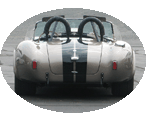 
 Main Menu
Main Menu
|
 Nevada Classics
Nevada Classics
|
 Advertise at CC
Advertise at CC
|
| S |
M |
T |
W |
T |
F |
S |
| |
|
|
|
|
|
1 |
| 2 |
3 |
4 |
5 |
6 |
7 |
8 |
| 9 |
10 |
11 |
12 |
13 |
14 |
15 |
| 16 |
17 |
18 |
19 |
20 |
21 |
22 |
| 23 |
24 |
25 |
26 |
27 |
28 |
29 |
| 30 |
|
|
|
|
|
|
|
 CC Advertisers
CC Advertisers
|
|
 7Likes 7Likes

02-17-2013, 08:47 PM
|
 |
CC Member

|
|
|
Join Date: Feb 2007
Location: Colorado Springs,
CO
Cobra Make, Engine: Backdraft, supercharged Coyote
Posts: 2,453
|
|

 Not Ranked
Not Ranked

Quote:
Originally Posted by ERA Chas

Cobras don't tolerate maximum torque unless you have a live axle and slicks.
|
Depends on what you mean by "maxiumum", and the application. I'm making a lot of torque, across a broad range. As long as the track is dry, I'm always looking for more torque.
There's no such thing as too much power, only not enough control.
Quote:
Originally Posted by Jerry Clayton

Turn 3 isn't headed for the backstrech------turn 4!!!!!!!!!!!!!
|
Not at High Plains Raceway! Turn 3 opens out on to a long down hill back stretch.
Quote:
Originally Posted by AL427SBF

Since you now define road course use, build for HP. You only leave from rest once there.
|
Not true. Every time you come out of a corner, you need all the torque you can get. You're not starting out from 0, but you're often coming from 60 and heading for 150.
Since I have a lot of torque everywhere, I don't have to shift much. I use 3rd and 4th only. Every time you shift you lose time, and have the potential to upset the car. And it gives you more things to do while you're already pretty busy.
I'v ridden in other cars that don't have as much torque, and have to work harder to keep the engine in it's power band. There's often a lot of shifting going on. That's especially difficult when pulling a steep hill.
__________________
.boB "Iron Man"
NASA Rocky Mountain TTU #42
www.RacingtheExocet.com
BDR #1642 - Supercharged Coyote, 6 speed Auto
|

02-18-2013, 06:48 AM
|
 |
CC Member

|
|
|
Join Date: Feb 2002
Location: Dadeville,
AL
Cobra Make, Engine: Sold my EM.
Posts: 2,459
|
|

 Not Ranked
Not Ranked

The best short answer above is, IMHO, scottj's. As he has got more race track experience than most here, I value his opinion.
From an engineers perspective, the burning fuel in each cylinder's power stroke serves only to apply a pushing force to the piston. That force is transferred through the connecting rod to the offset arm of the crankshaft creating a brief rotational torque. (Force of piston X Length of crankshaft arm = Torque on crankshaft). That torque is transferred through the rest of the drive train to the wheel(s). When the drive train tries to rotate the wheel, friction between the tire and ground usually makes it easier to move the car forward than to slide the tire on the ground. In this instance, the rotational torque of the wheel is converted to a linear push against the ground. (Torque of wheel / Radius of wheel = Force pushing car forward). ... As Newton taught us, applying force to an object will cause it to accelerate per the formula: Force = Mass X Acceleration. So, the theoretical rate at which a car will accelerate is directly related to the torque created by the engine.
BUT, we don't drive our cars in a vacuum, so as we gain speed the air begins to push back against us. Consequently, a car producing a steady torque will accelerate from 10 to 20 MPH more quickly than from 80 to 90 MPH. And ultimately we will reach a speed where the push back from the air and everything else will equal the push forward from the engine causing the acceleration to slow to zero (i.e., top speed).
Recall that each piston produces a pushing force and subsequent torque only momentarily during its power stroke. If we increase the number of pistons or the RPM we can increase the number of power strokes from the engine per second. This is what horsepower is all about. Horsepower can be expressed as: Torque / Time or Foot-Pounds per Second. It is a calculated number derived from the average amount of torque produced by an engine over time. This relationship makes it obvious why engine horsepower typically increases as the RPM increases, up to a point.
The horsepower number most often quoted for an engine is its peak horsepower at a specific RPM. IMHO, that is useful information only if you plan to spend most of your driving time at that RPM (e.g., NASCAR Daytona). Otherwise, saying your car performs well because it has a 600 HP engine is kind of like saying a person should be able to fix your car because he has an IQ of 150.
For my use, I value my car's ability to accelerate over a variety of speeds more than it's top speed. For that reason, I had my engine built with a big flat torque curve from 3,000 - 6,000 RPM. I want the engine to last, so I limited it to 6,000. If I were a real competitor like scottj, I would have moved the torque curve higher up the RPM range.
__________________
Tommy
Cheetah tribute completed 2021 (TommysCars.Weebly.com)
Previously owned EM Cobra
"Never attribute to malice that which is adequately explained by stupidity." - Hanlon's Razor
|

02-18-2013, 04:41 PM
|
|
CC Member

|
|
|
Join Date: Apr 2011
Posts: 1,092
|
|

 Not Ranked
Not Ranked

Quote:
Originally Posted by bobcowan

Depends on what you mean by "maxiumum", and the application. I'm making a lot of torque, across a broad range. As long as the track is dry, I'm always looking for more torque.
There's no such thing as too much power, only not enough control.
Not at High Plains Raceway! Turn 3 opens out on to a long down hill back stretch.
Not true. Every time you come out of a corner, you need all the torque you can get. You're not starting out from 0, but you're often coming from 60 and heading for 150.
Since I have a lot of torque everywhere, I don't have to shift much. I use 3rd and 4th only. Every time you shift you lose time, and have the potential to upset the car. And it gives you more things to do while you're already pretty busy.
I'v ridden in other cars that don't have as much torque, and have to work harder to keep the engine in it's power band. There's often a lot of shifting going on. That's especially difficult when pulling a steep hill.
|
Actually, this quote came from ERA Chas ...
Since you now define road course use, build for HP. You only leave from rest once there.
My reply is in sync with you ...
Actually, anytime I want to accelerate I will be calling on torque, all gears over a broad RPM range.

|

02-18-2013, 05:36 PM
|
 |
Half-Ass Member

|
|
|
Join Date: Jun 2005
Cobra Make, Engine: ERA #732, 428FE (447 CID), TKO600, Solid Flat Tappet Cam, Tons of Aluminum
Posts: 22,025
|
|

 Not Ranked
Not Ranked
Quote:
Originally Posted by AL427SBF

Actually, anytime I want to accelerate I will be calling on torque, all gears over a broad RPM range.
|
Sooooo, I guess you're fed up with your small block, huh?  |

02-18-2013, 05:39 PM
|
|
CC Member

|
|
|
Join Date: Oct 2003
Posts: 4,078
|
|

 Not Ranked
Not Ranked
Quote:
Originally Posted by patrickt

Sooooo, I guess you're fed up with your small block, huh?  |
If you take this bait the smart guys will cease contributing to the discussion.... 
__________________
Chas.
|

02-18-2013, 05:47 PM
|
 |
Half-Ass Member

|
|
|
Join Date: Jun 2005
Cobra Make, Engine: ERA #732, 428FE (447 CID), TKO600, Solid Flat Tappet Cam, Tons of Aluminum
Posts: 22,025
|
|

 Not Ranked
Not Ranked
Quote:
Originally Posted by ERA Chas

If you take this bait the smart guys will cease contributing to the discussion....  |
 |

02-18-2013, 05:59 PM
|
|
CC Member

|
|
|
Join Date: Apr 2011
Posts: 1,092
|
|

 Not Ranked
Not Ranked
Quote:
Originally Posted by ERA Chas

If you take this bait the smart guys will cease contributing to the discussion....  |
The discussion was over when Bob and a few other smart guys confirmed what I sort of thought, torque is king, tune for a big flat one  |
 Posting Rules
Posting Rules
|
You may not post new threads
You may not post replies
You may not post attachments
You may not edit your posts
HTML code is Off
|
|
|
All times are GMT -7. The time now is 03:04 PM.
Links monetized by VigLink
|


